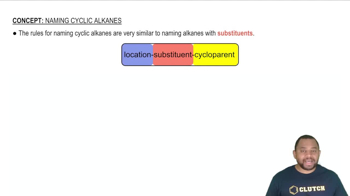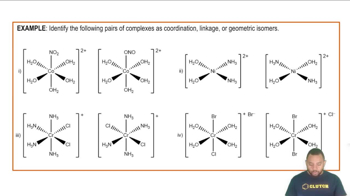Ch.23 - Organic and Biological Chemistry
Chapter 23, Problem 81
Unlike palmerolide A (Problem 23.80), which has a large ring, a cyclic molecule with only six atoms can only have a cis double bond, but not a trans double bond. Give a line drawing of a cyclic molecule with six carbon atoms and a cis double bond. Explain why it cannot have a trans double bond.
 Verified step by step guidance
Verified step by step guidance1
Step 1: Begin by drawing a hexagonal ring to represent a cyclic molecule with six carbon atoms. This is known as cyclohexene when it contains a double bond.
Step 2: Identify the position where the double bond will be placed. In cyclohexene, the double bond is typically between two adjacent carbon atoms.
Step 3: Draw the double bond between two of the carbon atoms in the ring. Ensure that the remaining carbon atoms are single-bonded to each other to complete the hexagonal structure.
Step 4: Add hydrogen atoms to each carbon atom to satisfy the tetravalency of carbon. Each carbon should have a total of four bonds, including the bonds in the ring and the double bond.
Step 5: Explain why a trans double bond is not possible in a six-membered ring. A trans double bond would require the substituents on the double-bonded carbons to be on opposite sides, which would introduce significant ring strain due to the geometric constraints of a small ring, making it energetically unfavorable.
Key Concepts
Here are the essential concepts you must grasp in order to answer the question correctly.
Cyclic Molecules
Cyclic molecules are compounds where carbon atoms are connected in a ring structure. In six-membered carbon rings, the spatial arrangement of atoms can significantly influence the types of bonds that can form. The rigidity of the ring limits the rotation around the carbon-carbon bonds, which is crucial for understanding the types of isomers that can exist.
Recommended video:
Guided course

Rules for Naming Cyclic Alkanes
Cis and Trans Isomerism
Cis and trans isomerism refers to the different spatial arrangements of substituents around a double bond. In a cis configuration, substituents are on the same side of the double bond, while in a trans configuration, they are on opposite sides. The ability to form these isomers depends on the flexibility of the molecule; in cyclic structures, this flexibility is restricted, particularly for six-membered rings.
Recommended video:
Guided course

Isomerism in Coordination Complexes Example
Steric Hindrance
Steric hindrance occurs when atoms in a molecule are forced into close proximity, leading to repulsion and instability. In a six-membered cyclic molecule with a trans double bond, the bulky groups on opposite sides would experience significant steric strain, making the configuration energetically unfavorable. This strain prevents the formation of stable trans isomers in such cyclic structures.
Related Practice
